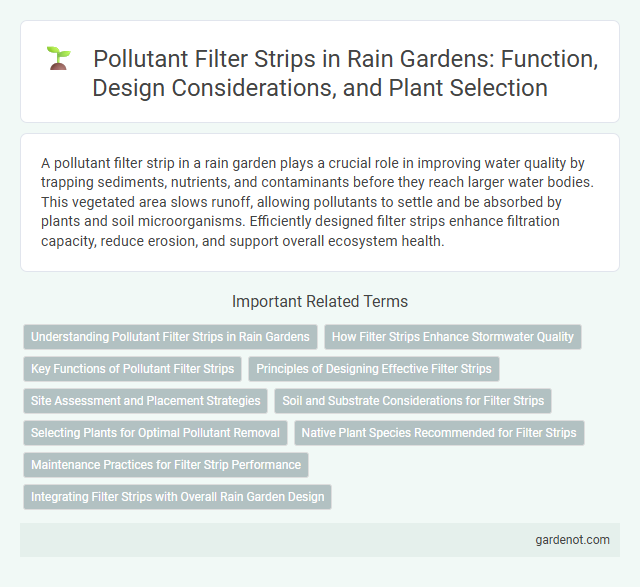A pollutant filter strip in a rain garden plays a crucial role in improving water quality by trapping sediments, nutrients, and contaminants before they reach larger water bodies. This vegetated area slows runoff, allowing pollutants to settle and be absorbed by plants and soil microorganisms. Efficiently designed filter strips enhance filtration capacity, reduce erosion, and support overall ecosystem health.
Understanding Pollutant Filter Strips in Rain Gardens
Pollutant filter strips in rain gardens function as vital components designed to capture and remove contaminants such as sediments, nutrients, and heavy metals from stormwater runoff. These vegetated buffers rely on dense plant root systems and permeable soil to promote infiltration, biodegradation, and sedimentation processes, significantly reducing the pollutant load entering waterways. Studies indicate that well-designed pollutant filter strips can improve stormwater quality by up to 60-80%, making them essential for sustainable urban water management.
How Filter Strips Enhance Stormwater Quality
Filter strips play a crucial role in enhancing stormwater quality by effectively trapping sediments, nutrients, and pollutants before they enter water bodies. These vegetated areas slow down runoff, promoting infiltration and allowing contaminants to settle out or be absorbed by plant roots. By reducing the load of harmful substances such as nitrogen, phosphorus, and heavy metals, filter strips protect aquatic ecosystems and improve overall water quality.
Key Functions of Pollutant Filter Strips
Pollutant filter strips effectively trap sediments, nutrients, and heavy metals from stormwater runoff before they enter water bodies. Vegetation within these strips slows water flow, promoting infiltration and enhancing pollutant absorption by soil microbes. Their primary function includes reducing nonpoint source pollution through natural filtration processes.
Principles of Designing Effective Filter Strips
Designing effective pollutant filter strips in rain gardens involves maximizing surface area with dense vegetation to enhance sediment capture and pollutant absorption. Incorporating native grasses and deep-rooted plants improves infiltration rates and stabilizes soil, reducing runoff volume and contaminant loading. Proper slope and soil permeability are critical for optimizing water flow and ensuring efficient filtration of nutrients, heavy metals, and hydrocarbons.
Site Assessment and Placement Strategies
Effective site assessment for pollutant filter strips involves analyzing soil permeability, slope gradient, and proximity to pollutant sources to maximize contaminant removal in rain gardens. Strategically placing filter strips downslope of impervious surfaces like driveways or rooftops enhances runoff capture and nutrient filtration. Optimal placement also considers existing vegetation and hydrologic pathways to prevent erosion while supporting biofiltration effectiveness.
Soil and Substrate Considerations for Filter Strips
Pollutant filter strips in rain gardens rely on carefully selected soil and substrate layers to maximize contaminant removal and water infiltration. Soils with high organic content and well-graded texture improve pollutant adsorption, while substrates with a mix of sand, silt, and clay enhance filtration efficiency and prevent clogging. Proper soil permeability and nutrient balance also support healthy vegetation growth, which contributes to pollutant uptake and overall filter strip performance.
Selecting Plants for Optimal Pollutant Removal
Selecting plants for pollutant filter strips in rain gardens involves choosing species with high nutrient uptake and tolerance to fluctuating moisture levels. Grasses such as Panicum virgatum and shrubs like Cornus sericea effectively absorb heavy metals and organic contaminants from stormwater runoff. Incorporating native wetland plants enhances microbial activity in the soil, further improving the breakdown of pollutants and overall water quality.
Native Plant Species Recommended for Filter Strips
Native plant species recommended for pollutant filter strips in rain gardens include switchgrass (Panicum virgatum), black-eyed Susan (Rudbeckia hirta), and swamp milkweed (Asclepias incarnata). These plants effectively trap sediments, absorb excess nutrients like nitrogen and phosphorus, and enhance soil infiltration. Their deep root systems improve water filtration and promote pollutant breakdown, supporting overall ecosystem health.
Maintenance Practices for Filter Strip Performance
Regular maintenance of pollutant filter strips in rain gardens is essential to preserve their effectiveness in trapping sediments, nutrients, and pollutants. Routine practices include removing accumulated debris, controlling invasive vegetation, and inspecting for erosion or sediment buildup to prevent flow obstruction. Proper upkeep ensures optimal water infiltration and pollutant removal, maintaining the filter strip's long-term environmental benefits.
Integrating Filter Strips with Overall Rain Garden Design
Integrating pollutant filter strips with the overall rain garden design enhances the efficiency of stormwater management by capturing sediments, heavy metals, and nutrients before they reach the main garden area. Filter strips composed of dense vegetation and engineered soils improve infiltration rates and reduce surface runoff, promoting groundwater recharge. Precise placement along garden perimeters and inflow points maximizes pollutant removal, ensuring healthier ecosystems and sustained water quality.
Pollutant filter strip Infographic

 gardenot.com
gardenot.com